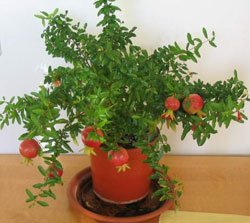 | Common pomegranate (Punica granatum) is a plant from the Pomegranate family (Punicaceae), belongs to the genus Pomegranate (Punica). The name of the genus comes from the Latin "punicum", which means "Carthaginian", since in ancient times the fruits of the pomegranate were brought from Carthage. Deciduous tree 5-10 m high. Valuable fruit and highly decorative plant. In room culture, decorative dwarf forms are grown. « Full description Common pomegranate |
Question: How to grow a pomegranate from a seed?
Answer: Pomegranate seeds are sown in autumn (preferably in autumn) or spring. The composition of the earthen mixture: sod land with sand (1: 1).
Germination can be accelerated by maintaining the soil temperature at + 22-25 ° C
Seedlings dive into the soil mixture for sowing, one at a time in pots with a diameter of 5-7 cm. During the growth period, watered abundantly.
Seedlings overwinter at an air temperature of + 4-6 ° C - a prerequisite for obtaining well-developed plants in the future. During wintering, watering is reduced, especially after the leaves have fallen.
In the spring, I transfer young plants into pots with a diameter of 8-11 cm.
For the first 2-3 years, plants grow slowly, flowering usually occurs in 5-8 years.
Question: How to determine if the fruit is ripe on a pomegranate?
Answer: Ripe pomegranates have a reddish-brown skin and a little warp.
The safest way to determine maturity is by taste. True, if you have a decorative form of pomegranate, then its fruits are not edible.
Question: How to trim correctly?
Answer: It is better to prune in the spring, in late February-early March, on growing daylight hours. The twigs are shortened to the outer bud (the one that looks from the crown) to the desired length. It is important that the branches do not grow deeper into the crown and do not shade themselves. It is advisable to shorten the length to the same length so that the crown does not look "unkempt".
Question: Can you please tell me how to make a pomegranate set a fruit?
Answer: The fact is that not all flowers set fruit. They are of two types: with short bell-shaped columns - sterile (that is, sterile) and fertile - with long columns (pitcher-shaped). The massive appearance of sterile flowers makes the plant very elegant, decorative, but damages the growth of fruits. Therefore, such flowers are recommended to be removed.
Question: The pomegranate leaves and flowers fall. What can be done? Spray?
Answer: Falling leaves occur from a lack or excess of water during irrigation, from low air humidity, when damaged by pests, diseases and for a natural reason - leaf fall, leaf change.
Flowers also fall naturally. In the pomegranate, most of the flowers are sterile, after flowering they do not form ovaries and fall off.
It is not recommended to spray any plant during flowering, as spots appear on the flowers.
Question: The pomegranate grows in the garden, blooms, but there is no fruit. What can be done? Something to feed?
Answer: If your pomegranate grows not in the south of Russia, but in the middle lane, you will not be able to get fruits. And, unfortunately, he will freeze out. And if it's the south, or the winter garden, or the warm West, then yes, you can expect fruiting.
Pomegranate is a cross-pollinated plant. It has the so-called "long-columnar" and "short-columnar" flowers, there are also intermediate forms. Fruits give only "long-columnar" flowers. For better pollination, you need to have several plants.
The number of flowers of different types and their ratio depends on the variety and some other factors. Sometimes the same variety in the same climate produces flowers of both types and bears fruit well, sometimes only sterile short-columnar flowers are formed. Ornamental varieties produce, as a rule, only "short-columnar" flowers, and do not bear fruit, or there are fruits, but they are not edible.
Top dressing, alas, will not help matters.You can use drugs that stimulate flowering and fruiting, for example, Pollen, Bud, Ovary and the like, however, this does not give a 100% guarantee.
Artificial pollination can be carried out - you need to take a flower with ripe (dusty) stamens and apply pollen to the pistils of jug-like flowers. You can take the pollen with a thin brush and pollinate the desired pistils.
Question: There are some pests on the leaves and flowers. How to exterminate them?
Answer: It is difficult to determine exactly what kind of pest it is without seeing it or the damage it inflicts. Most often, pomegranate affects thrips, whitefly, spider mites. You can wash the leaves with water or soapy water. You can use Agrovertin, Actellik, Decis, Karate preparations for spraying. You can use the drug Aktara - add it to the irrigation water and spray the leaves on both sides (although Aktara will not help against the spider mite).
During treatments, be sure to use personal protective equipment - respirator, glasses, gloves.









